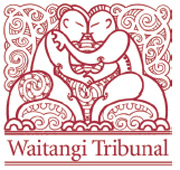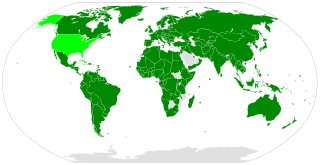Closing the Gaps was a policy of the Fifth Labour Government of New Zealand for assisting socio-economically disadvantaged Māori and Pasifika ethnic groups in New Zealand through specially targeted social programmes. The phrase "Closing the Gaps" was a slogan of the Labour Party in the 1999 election campaign and was implemented as a policy initiative in the 2000 Budget.

The Waitangi Tribunal is a New Zealand permanent commission of inquiry established under the Treaty of Waitangi Act 1975. It is charged with investigating and making recommendations on claims brought by Māori relating to actions or omissions of the Crown, in the period largely since 1840, that breach the promises made in the Treaty of Waitangi. The Tribunal is not a court of law; therefore, the Tribunal's recommendations and findings are not binding on the Crown. They are sometimes not acted on, for instance in the foreshore and seabed dispute.
The term "minority group" has different usages, depending on the context. According to its common usage, the term minority group can simply be understood in terms of demographic sizes within a population: i.e. a group in society with the least number of individuals, or less than half, is a "minority". Usually a minority group is disempowered relative to the majority, and that characteristic lends itself to different applications of the term minority.

The International Covenant on Economic, Social and Cultural Rights (ICESCR) is a multilateral treaty adopted by the United Nations General Assembly (GA) on 16 December 1966 through GA. Resolution 2200A (XXI), and came into force on 3 January 1976. It commits its parties to work toward the granting of economic, social, and cultural rights (ESCR) to all individuals including those living in Non-Self-Governing and Trust Territories. The rights include labour rights, the right to health, the right to education, and the right to an adequate standard of living. As of February 2024, the Covenant has 172 parties. A further four countries, including the United States, have signed but not ratified the Covenant.
Health equity arises from access to the social determinants of health, specifically from wealth, power and prestige. Individuals who have consistently been deprived of these three determinants are significantly disadvantaged from health inequities, and face worse health outcomes than those who are able to access certain resources. It is not equity to simply provide every individual with the same resources; that would be equality. In order to achieve health equity, resources must be allocated based on an individual need-based principle.
Cultural safety is the effective nursing practice of nursing a person or family from another culture; it is determined by that person or family. It developed in New Zealand, with origins in nursing education. An unsafe cultural practice is defined as an action which demeans the cultural identity of a particular person or family.
Pavee Point (PP) is a government-funded non-governmental organisation based in Dublin, Ireland that was formed to improve the human rights of Irish Travellers and to bridge the economic and social inequalities between Travellers and settled people. Irish Travellers are an ethnic minority group that originated from nomadic tradespeople.

The Convention on the Rights of Persons with Disabilities is an international human rights treaty of the United Nations intended to protect the rights and dignity of persons with disabilities. Parties to the convention are required to promote, protect, and ensure the full enjoyment of human rights by persons with disabilities and ensure that persons with disabilities enjoy full equality under the law. The Convention serves as a major catalyst in the global disability rights movement enabling a shift from viewing persons with disabilities as objects of charity, medical treatment and social protection towards viewing them as full and equal members of society, with human rights. The convention was the first U.N. human rights treaty of the twenty-first century.

Human rights in New Zealand are addressed in the various documents which make up the constitution of the country. Specifically, the two main laws which protect human rights are the New Zealand Human Rights Act 1993 and the New Zealand Bill of Rights Act 1990. In addition, New Zealand has also ratified numerous international United Nations treaties. The 2009 Human Rights Report by the United States Department of State noted that the government generally respected the rights of individuals, but voiced concerns regarding the social status of the indigenous population.
The Universal Periodic Review (UPR) is a state monitoring mechanism of the United Nations Human Rights Council (HRC). It was established by General Assembly resolution 60/251 in 2006 to periodically review the protection and promotion of human rights in each of the 193 United Nations (UN) Member States. New Zealand has been reviewed twice via the UPR in 2009 and 2014.
Structural inequality occurs when the fabric of organizations, institutions, governments or social networks contains an embedded cultural, linguistic, economic, religious/belief, physical or identity based bias which provides advantages for some members and marginalizes or produces disadvantages for other members. This can involve, personal agency, freedom of expression, property rights, freedom of association, religious freedom,social status, or unequal access to health care, housing, education, physical, cultural, social, religious or political belief, financial resources or other social opportunities. Structural inequality is believed to be an embedded part of all known cultural groups. The global history of slavery, serfdom, indentured servitude and other forms of coerced cultural or government mandated labour or economic exploitation that marginalizes individuals and the subsequent suppression of human rights are key factors defining structural inequality.
Societal racism is a type of racism based on a set of institutional, historical, cultural and interpersonal practices within a society that places one or more social or ethnic groups in a better position to succeed and disadvantages other groups so that disparities develop between the groups. Societal racism has also been called structural racism, because, according to Carl E. James, society is structured in a way that excludes substantial numbers of people from minority backgrounds from taking part in social institutions. Societal racism is sometimes referred to as systemic racism as well.

Women in New Zealand are women who live in or are from New Zealand. Notably New Zealand was the first self-governing country in the world where women were entitled to vote. In recent times New Zealand has had many women in top leadership and government roles, including three female Prime Ministers, most recently Jacinda Ardern.

The International Convention on the Elimination of All Forms of Racial Discrimination (ICERD) is a United Nations convention. A third-generation human rights instrument, the Convention commits its members to the elimination of racial discrimination and the promotion of understanding among all races. The Convention also requires its parties to criminalize hate speech and criminalize membership in racist organizations.
New Zealand suffers from one of the highest rates of child poverty in the Western world. According to Statistics New Zealand, by the end of June 2022, 12% of all children were directly affected by poverty. Historically, child poverty has had, and continues to have a disproportionately high effect on in Māori and Pasifika households, with 14.5% of Māori children and 19.5% of Pacific children living in poverty. These two ethnic groups continue to experience lingering effects of forced land alienation and immigration discrimination.
Local government bodies in New Zealand have responsibilities under the Local Government Act 2002 (LGA) to perform a wide range of functions, and provide a wide range of services to the communities they represent. There is not an explicit focus on human rights in New Zealand local government, or any direct reference to human rights under the LGA. Local bodies in New Zealand are required to act in a way that is consistent with the rights guaranteed under the New Zealand Bill of Rights Act 1990 (NZBORA). Internationally there is growing consideration of how local government does and could promote and protect fundamental rights.
Labour rights in New Zealand are largely covered by both statute, particularly the Employment Relations Act 2000, and common law. The Ministry of Business, Innovation and Employment carries out most of the day to day administrative functions surrounding labour rights and their practical application in the state.
Domestic violence in New Zealand, often called family violence or family harm is defined under New Zealand law as not only intimate partner violence but also violence against other family members, including children and extended family or whānau, as well as people living together in the same household, such as flatmates. It is estimated that one third of people in New Zealand have experienced intimate partner violence (IPV) within their lifetime, making New Zealand have the highest rate of domestic violence in 14 OECD countries. In 2020, New Zealand police responded to a domestic violence call every 4 minutes.

The COVID-19 pandemic has revealed race-based health care disparities in many countries, including the United States, United Kingdom, Norway, Sweden, Canada, and Singapore. These disparities are believed to originate from structural racism in these countries which pre-dates the pandemic; a commentary in The BMJ noted that "ethnoracialised differences in health outcomes have become the new normal across the world" as a result of ethnic and racial disparities in COVID-19 healthcare, determined by social factors. Data from the United States and elsewhere shows that minorities, especially black people, have been infected and killed at a disproportionate rate to white people.
The Human Rights Economy (HRE) envisages economies that are consistent with human rights laws. It is a conceptual framework introduced by the Office of the United Nations High Commissioner for Human Rights (OHCHR) indicating that all individuals and organs of society need to respect human rights (preamble, art 29). The OHCHR advocates for the adoption of the Human Rights Economy to ensure that economic and social decision-making are guided by human rights law. The concept posits that by applying human rights law to all aspects of society, a more equitable and sustainable economy will be created. The Human Rights Economy, like human rights, applies to all political and economic systems.







